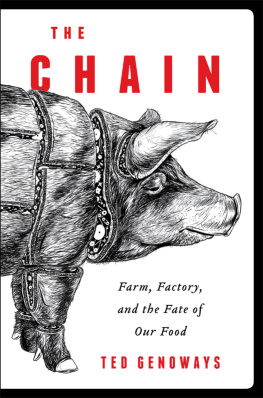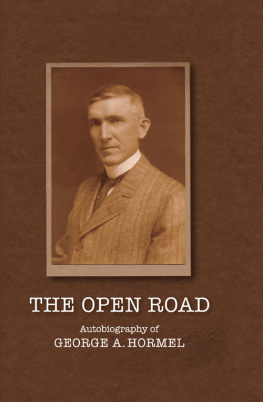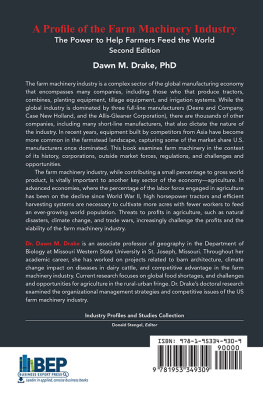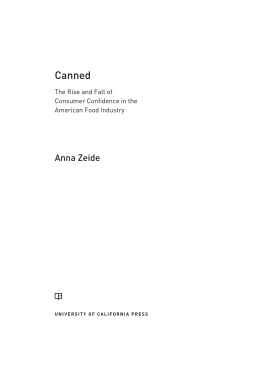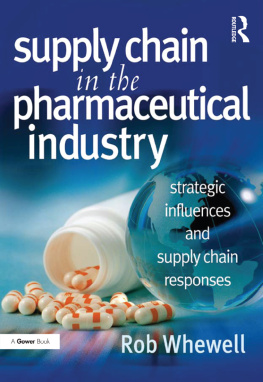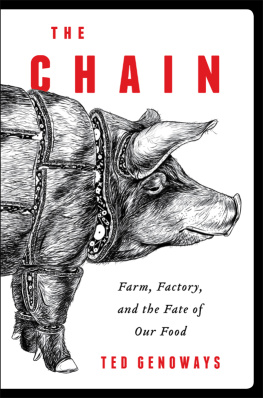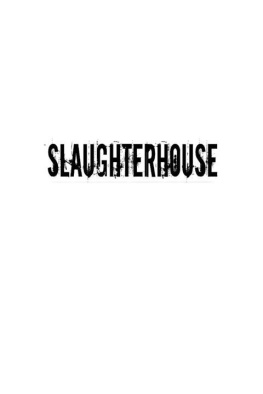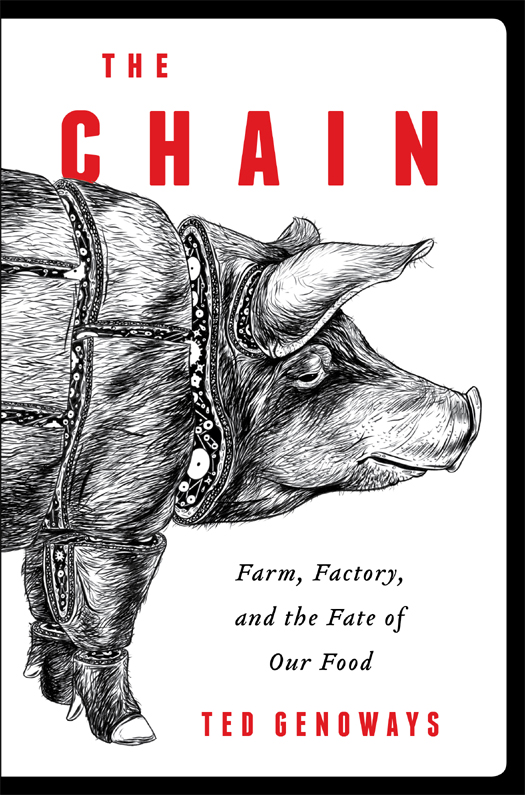For Jack
The speeding-up seemed to be growing more savage all the time.
Upton Sinclair, The Jungle
CONTENTS
Guide

Maria Lopez will never forget that day.
It was 2004, the middle of an ordinary shift on the line at Hormel Foodsa sprawling brick-and-concrete complex, just across the Union Pacific tracks on the southern edge of Fremont, Nebraska. The worker beside her fed pork shoulders one after another into a spinning saw, just as he did every other day of the week, while Lopez gathered and bagged the trimmed fat to go into Spam. The facility in Fremont was just one of two plants in the world where Hormel made its signature product, so the pace of work had always been steady. But the speed of the line had jumped recently, from 1,000 hogs per hour to more than 1,100, and Lopez was having trouble keeping up. As her coworker reached for another shoulder, she rushed to clear the cutting areaand her fingers slipped toward the saw blade. Lopez snatched her hand back, but it was too late. Her index finger dangled by a flap of skin, the bone cut clean through. She screamed as blood spurted and covered her workstation.
Later, a surgeon was able to shorten both ends of the bone and stabilize it with a screw before delicately repairing the tendons and reattaching the nerves and blood vessels. A month after that, Lopez needed another surgery to insert a second pin to straighten a crook in the bone. In the end, she lost all feeling in her fingerbut missed just two months of work. It was only after she returned to Hormel that Lopez discovered a stomach-turning truth: that while she sprinted to the nurses station and was taken to the Fremont Area Medical Center, while she waited, finger wrapped, in the emergency room for the surgeon to drive in from Omaha, the cut line at Hormel continued to run. That hour, like virtually every working hour, without interruption, the plant processed 1,100 hogstheir carcasses butchered into parts and marketed as Cure 81 hams or Black Label bacon, the scraps collected and ground up to make Spam and Little Sizzlers breakfast sausages. Her coworkers were instructed by floor supervisors to wash the station of her blood, but the line never stopped.
Maria remembered all this while she fried papas in the kitchen of her home on the outskirts of Fremont, her index finger pointed straight as she gripped the spatula. She told me that her numb finger made her clumsy at her job at Hormel, and she grew worried that her fumbling might lead to a more serious injury. In 2006, when the speed increased yet againthis time to more than 1,200 hogs per hourMaria quit. Her husband, Fernando, who still worked at the plant, told me that the line was now moving at more than 1,300 head per hour, and the injuries were increasing and becoming worse. He had a friend who was a gut snatcher, tasked with pulling innards from swinging carcasses. One day, when he took too long clearing an abdominal cavity, the backsaw cut through the spine and sliced off four of his fingers. I think he lose two of these, Fernando said, pointing to his middle and ring finger. Then, as if an afterthought, Fernando added that he too had lost part of a fingerthe tip of his left pinkie to a rib cutter. In every case, he said, they washed it up but never stopped production. Its terrible to work on the line.
Workers rights advocates agree. In September 2013, a coalition of civil rights groups, led by the Southern Poverty Law Center and the Nebraska Appleseed Center for Law in the Public Interest, called on the U.S. Occupational Safety and Health Administration (OSHA) and the U.S. Department of Agriculture (USDA) to reduce the speed of the processing line to minimize the severe and systemic risks faced by American meatpackers, such as repetitive stress injuries and cuts and amputations, which affect meatpacking workers at alarming rates. They pointed to an extensive study of packinghouse employees conducted by Nebraska Appleseed in 2009, which found that 52 percent of all workers felt that conditions had become less safe in the last twelve months, with the vast majority citing line speed as the cause. Despite the report, all of the plants studied had seen further speedups in the intervening years.
But only a handful of packinghouses in the entire country have been permitted to run as fast as the Hormel plant in Fremont. Thanks to a special program piloted by the USDA more than a decade ago to test the effects of reduced inspection on food safety, five pork processing facilities nationwide have been allowed to set their own line speeds. And Hormel managed to get all three of the slaughter operations that it owns or operates into that select handful. This increase in work speed positioned Hormel to capitalize on the coming economic crisis and the demand it created for budget-friendly meat like Spam. But this seemingly minor change in plant operationupping the speed of slaughter on just three kill floors and speeding butchering and processing in just the two plants where Hormel manufactures Spamalso set off a wide-ranging and sometimes disastrous series of events.
What follows, then, is not just the tale of what happened when Hormel decided to speed up production but also an examination of the knock-on effects of that decision, over a period of years, up and down the supply chainfrom the confinement facilities where high-density hog farming increasingly threatens environmental quality and animal welfare to the packinghouses where workers face some of the most dangerous working conditions in the country and hostility from the communities where they live to the butcher counter at the supermarket, where the safety and wholesomeness of the food supply have been jeopardized. It is a portrait of American industry pushed to its breaking point by the drive for increased output but also a cracked mirror in which to see our own complicity, every time we choose low-cost and convenience over quality. It is, in short, an attempt to calculate the true price of cheap meat.

On the kill floor of Quality Pork Processors Inc., the wind always blows: from the open doors at the docks where drivers unload massive trailers of screeching pigs, through the overheated room where the hogs are butchered, to the plastic-draped breezeway where the parts are handed over to Hormel Foods for packaging. The air gusts and swirls, whistling through the plant like the current in a canyon. In the first week of December 2006, Matthew Garcia felt feverish and chilled on the blustery production floor. He fought stabbing back pains and vomiting, but he figured it was just the flu. El Nio had touched the prairies of southern Minnesota with unusually warm air that fall, and public health officials were warning that powerful strains of influenza might sweep the state. But he was still in his teens and strongand he was determined to tough it out.
Garcia had gotten on at QPP in Austin, just two hours south of MinneapolisSt. Paul, only twelve weeks before and had been stuck with one of the worst spots on the line: running a device known simply as the brain machinethe last stop on a conveyor snaking down the middle of a J-shaped, steel-encased bench called the head table. Every hour, more than 1,300 severed pork heads went sliding along the belt. Workers sliced off the ears, clipped the snouts, chiseled the cheek meat. They scooped out the eyes, carved out the tongues, and scraped the palate meat from the roofs of mouths. Because, famously, all parts of a pig are edible (everything but the squeal, wisdom goes), nothing was wasted, not even the brains. A few years before Garcia started on the line, someone up the chain of command, someone at Hormel, had found a buyer in Korea, where liquid pork brains are used as a thickener in stir-fry.

